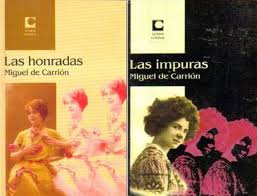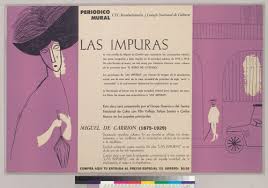 MIGUEL DE CARRIÓN, escritor: ‘LAS IMPURAS Y ‘LAS HONRADAS’ MUESTRAS DEL REALISMO CUBANO.
MIGUEL DE CARRIÓN, escritor: ‘LAS IMPURAS Y ‘LAS HONRADAS’ MUESTRAS DEL REALISMO CUBANO.
El incumplido sueño martiano de una Cuba «con todos y para el bien de todos»; la desigualdad de clases; las problemáticas raciales; la corrupción político administrativa de los sucesivos gobiernos Según la crítica fueron las principales causas que cristalizaron el sentimiento de frustración nacional en una naciente República con apéndice plattiano. En ello se incluye el generalizado pesimismo de la intelectualidad cubana que, en vano, cifraba sus esperanzas en la regeneración moral de un país, después de cruentos años de lucha por alcanzar su independencia. De esos autores, Jesús Castellanos, Carlos Loveira y Miguel de Carrión —significativos narradores de la promoción literaria del primer tercio sigloventista, furon los llamados escritores «agonizantes».
MIGUEL DE CARRION.
Medicina y literatura fueron dos profesiones que Miguel Antonio de Carrión de Cárdenas combinó de manera perfecta. También este habanero nacido el 9 de abril de 1875 desempeñó una encomiable labor en el campo del periodismo pues colaboró activamente con diversas publicaciones. Tras graduarse de bachiller en la capital ingresó en la Escuela de Derecho de la Universidad de la Habana, pero la abandonó al estallar la guerra de independencia debido a sus actividades revolucionarias.
Sus ideas emancipadoras lo obligaron a emigrar a los Estados Unidos, donde más tarde montó un negocio de billar y escribió sus narraciones.
Regresa a comienzos del siglo XX para graduarse de médico e ingresar en la Sociedad de Estudios Clínicos de La Habana mientras la rectoría de la Universidad le adjudica la Ayudantía Facultativa del Departamento de Rayos Equis, adscrita a la Escuela de Medicina.
Polifaceta defensor de las mujeres
Miguel de Carrión se destacó en varias esferas. Prestó servicios en la Asociación Cubana de Beneficencia, y ganó por oposición las cátedras de Educación Física, Juegos y Deportes, y de Anatomía, Fisiología e Higiene en la Escuela Normal.
Impartió conferencias de Instrucción Moral y Cívica, fundó la revista ‘Cuba Pedagógica’. Creó junto a Félix Callejas la revista para niños ‘La Edad de Oro’, título homónimo al de la revista martiana, dedicada a promover el pensamiento de Martí. Como periodista colaboró con numerosas publicaciones entre ellas, El Fígaro y Heraldo de Cuba, además de publicar Los cálculos renales y su diagnóstico.
Su vocación pedagógica y sociológica se volcó hacia la condición social de las mujeres, lo que refleja durante toda su obra narrativa. Nadie duda que la trayectoria de Carrión como novelista —cuatro obras, una de ellas de publicación póstuma— es la más destacada y conocida, aunque no deben descartarse los cuentos y noveletas publicados, durante casi treinta años en las revistas más leídas de la época. Sus inquietudes literarias se remontan a su etapa como emigrado, pues fue en los Estados Unidos donde escribió El milagro, inédita hasta 1903, novela de corte psicológico, adscrita a la estética naturalista predominante en toda su trayectoria literaria, fundamentalmente en sus narrativas capitales.
Sus novelas ‘El Milagro’, ‘Las Impuras’ y ‘Las Honradas’ se consideran la mejor muestra del realismo cubano.
En ‘Las impuras’ expone diversas problemáticas sociales: el caos, el hampa, la politiquería y la prostitución en la ciudad. Como acierto importante de la obra, se muestra la condición de las mujeres consideradas «descartables» desde la óptica falocentrista, convertidas en objeto de placer en el entonces floreciente y lucrativo negocio del comercio sexual en una urbe que abría sus puertas al cosmopolitismo.
Miguel de Carrión y Cárdenas, falleció el 29 de julio de 1929, en su residencia en el fastuoso y emergente barrio capitalino de El Vedado, vivió 54 años.
 MIGUEL DE CARRION:’ THE IMPURAS AND ‘THE HONORED’ SAMPLES OF CUBAN REALISM.
MIGUEL DE CARRION:’ THE IMPURAS AND ‘THE HONORED’ SAMPLES OF CUBAN REALISM.
The unfulfilled Marti dream of a Cuba «with all and for the good of all»; the inequality of classes; the racial problems; The political and administrative corruption of the successive governments According to the criticism, they were the main causes that crystallized the feeling of national frustration in a nascent Republic with a Plattian appendix. This includes the widespread pessimism of the Cuban intelligentsia that, in vain, pinned its hopes on the moral regeneration of a country, after fierce years of struggle to achieve its independence. Of those authors, Jesus Castellanos, Carlos Loveira and Miguel de Carrión -significant narrators of the literary promotion of the first third centuryventist, furon the so-called “dying” writers.
MIGUEL DE CARRION.
Medicine and literature were two professions that Miguel Antonio de Carrión de Cárdenas combined in a perfect way. This Havana born April 9, 1875 also played a commendable role in the field of journalism as he actively collaborated with various publications. After graduating from high school in the capital, he entered the Law School of the University of Havana, but abandoned it when the independence war broke out due to his revolutionary activities.
His emancipatory ideas forced him to emigrate to the United States, where he later set up a billiard business and wrote his narrations.
He returned at the beginning of the 20th century to graduate as a doctor and to join the Clinical Studies Society of Havana while the rector of the University awarded him the Facultative Assistant of the Department of Rays Equis, attached to the School of Medicine.
Miguel de Carrión stood out in several areas. He served in the Cuban Association of Charities, and won by opposition the chairs of Physical Education, Games and Sports, and Anatomy, Physiology and Hygiene in the Normal School.
He gave lectures on Moral and Civic Instruction, founded the magazine ‘Cuba Pedagógica’. Together with Felix Callejas, he created the children’s magazine ‘La Edad de Oro’, a title of the same name as the Martí magazine, dedicated to promoting Martí’s thought. As a journalist he collaborated with numerous publications including El Fígaro and Heraldo de Cuba, as well as publishing The Kidney Stones and his diagnosis.
His pedagogical and sociological vocation turned to the social condition of women, which reflects throughout his narrative work. No one doubts that Carrión’s career as a novelist – four works, one of them published posthumously – is the most prominent and well-known, although stories and novels published for thirty years in the most widely read magazines of the time should not be discarded. His literary concerns go back to his time as an emigrant, since it was in the United States where he wrote El milagro, unpublished until 1903, a psychological novel, ascribed to the naturalist aesthetic predominant throughout his literary career, mainly in his capital narratives.
His novels ‘El Milagro’, ‘Las Impuras’ and ‘Las Honradas’ are considered the best example of Cuban realism.
In ‘Las Impuras” exposes various social problems: chaos, the underworld, politicking and prostitution in the city. As an important success of the work, it shows the condition of women considered “disposable” from the phallocentric perspective, turned into an object of pleasure in the then flourishing and lucrative business of sex trade in a city that opened its doors to cosmopolitanism.
Miguel de Carrión y Cárdenas, died on July 29, 1929, at his residence in the lavish and emerging capital district of El Vedado, lived 54 years.
Agencies/ RHC/ Gardenia Companioni/ Lorena Viñas/ Extractos/ Internet Photos/ Arnoldo Varona, Editor/ www.TheCubanHistory.com
THE CUBAN HISTORY, HOLLYWOOD.



 < MIGUEL DE CARRIÓN, writer: "Las Impuras" and "Las Honradas"', Samples of Cuban Realism.
< MIGUEL DE CARRIÓN, writer: "Las Impuras" and "Las Honradas"', Samples of Cuban Realism.






